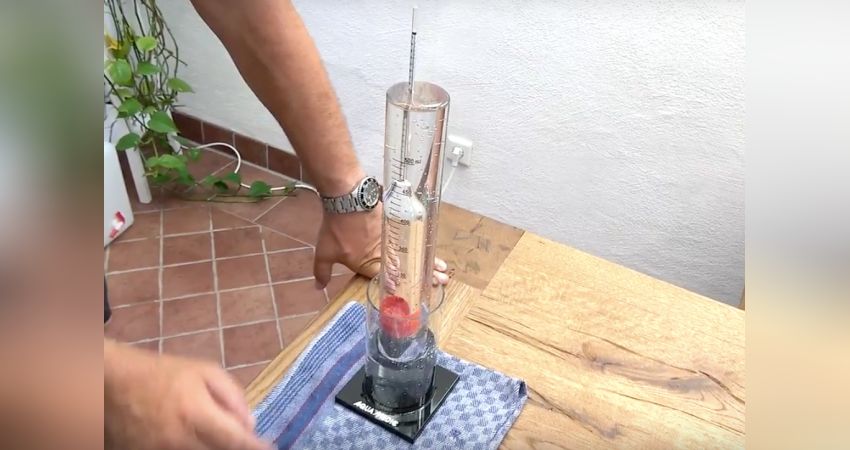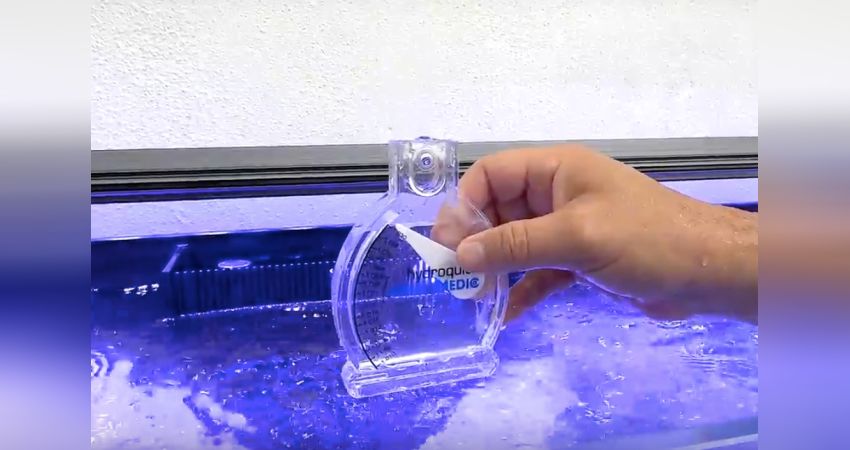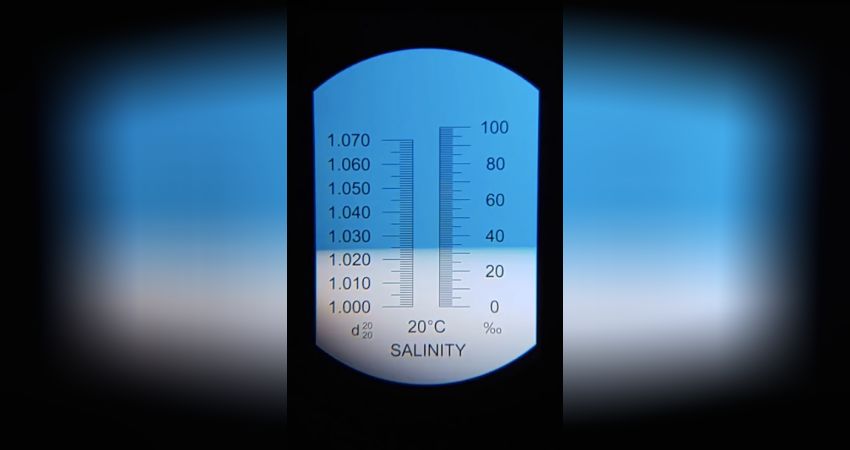How a seawater aquarium is created-Part 8: The salt, salinity and density

Messung mit der Spindel
Finally we have enough water and salt is added to our aquarium. Now it's time to look at terms like salinity and density. An article about the importance and the different ways of measuring salinity.
In our aquarium it is now time to add the salt to the osmosis water. Please make sure that you add less salt than you need at first. It is easier to add more than to compensate for too much salt.
We have calculated the amount as follows
.315 litres of water content because of the 5cm edge in the main tank, plus 85 litres content in the filter tank. Total just under 400 litres. From this we subtract the stones, about 20 kilograms/litre. Since the filter tank is not completely full, I calculated 330 litres at the end. The FaunaMarin Professional salt used should be approx. 39 grams per litre. Extrapolating I added about 12 kilos of salt and then adjusted it later so that we had 1.0235 salt content.
.By the way, this FaunaMarin salt is exactly as it should be, i.e. it has exactly the same values as the sea. It is certainly worth mentioning that there are also salts that are more suitable for fish tanks (have fewer trace elements), or others that, for example, have significantly more KH.
.We have taken the trouble to list some interesting facts about salt measurement below.
Summarised values:
Magnesium: 1,250 - 1,340 mg/l
Calcium: 410 - 440 mg/l
Potassium / Potassium: 380 - 400 mg/l
Sodium: 10,300 - 10,700 mg/l
Chlorides: 19.100 - 19,800 mg/l
Sulphates / Sulphate: 2650 - 2750 mg/l
Alkalinity in dKH: 8.0-8.5°
pH: 8.0-8.4
Strontium: 7.0-9.0 mg/l
Here now the video of the salting up
.
Salinity or density?
In these days of magnificent stony coral tanks, measuring density or salinity in particular is hugely important. There are quite a few who have unknowingly increased or decreased this value over time and then wondered about the death of stony corals. This value is usually measured last, long after the usual water parameters such as calcium, nitrate, phosphate and magnesium. Since there are still many misunderstandings and misinterpretations today, we have taken the time to summarise what is worth knowing about the possibilities of measuring salinity in a marine aquarium.
I would not consider the following measuring device to be particularly accurate. If you use such a device, you have to make sure that it is always cleaned very carefully with fresh water. These pointers are not as precise as a spindle usually is.
Hydroquik
The spindle (aerometer)
The optimum density is between 1.0235 at a temperature of 25 degrees Hydrometers come in both a small and a large version. As you can guess, the larger spindles are supposed to measure more accurately. The big disadvantage of these hydrometers is that they break very easily. It is always advisable to measure the density in a separate vessel, as it is extremely difficult or impossible to do so while the aquarium is in operation.
There are measuring cylinders that fit perfectly for a large hydrometer. You can buy one of these in aquarium shops, for example. Of course, it also works with a large glass or bucket.
A salinity of 35 per mille corresponds to a density of 1.0233 or a specific gravity of 1.0264
at 25°C.Messung mit der Spindel
The refractometer:
The application with a refractometer is in itself very simple. You take a few drops of aquarium water and pipet it onto the refractometer's carrier. It is nice that many refractometers have a temperature compensation and you do not have to pay attention to the temperature during the actual measurement. However, the small difference is quickly compensated for by the small amount of water needed. This means that water with a temperature of 25 degrees cools down to 20 degrees very quickly when it is pipetted onto the carrier.
Salinity is the content (in ‰) of dissolved salts per kilogram of seawater. Salinity is therefore not temperature-dependent, like density or conductivity. For this reason, I can only urgently advise everyone to disregard the left-hand scale of the display at all and to use only the right-hand scale when using a refactometer. The salinity should be 34 - 35‰. I personally find some refractometers hard to read! You shouldn't skimp here and it's best to take a look beforehand :-)
.Ansicht Refraktometerskala
Summarising:
China refractomer = often inaccurate and sometimes difficult to read
Spindle: much more accurate,... but for quick and frequent use definitely more time-consuming.
One could name two digital refractometers, e.g. the Greisinger GLF 100 (approx. 185 Euro) that measures conductivity and water temperature, or the Milwaukee MA887 (measures salinity and ambient temperature) that is more often used and costs approx. 120 - 130 Euro. Both are certainly more accurate than all the aforementioned devices, and above all quicker to use.
Conclusion:
Overall, it is of course more important to keep the salinity in the tank constant than to set it to a certain value. Special care should be taken if there is a discrepancy between a new device and the old one.For this does not have to mean that one of the two is more accurate or less accurate, but it may simply be that they are designed for different temperature ranges.
.Best regards
Team CoralReef.com
How do you like this article?
Info
Author

Bookmark
Comments
Topics
Similar articles
- How a marine aquarium is created Part 47: The Armatus 400 after 30 months
- How a marine aquarium is created-Part 23: The water level - drain problem in the marine aquarium
- How a marine aquarium is created Part 25: Fighting the glass lice
- 11 - Calcium supply:
- 33 - Butterflyfish in a community aquarium?
- 12 - Start-up phase of a saltwater aquarium
- 10 - Water, substrate and tank equipment
- How a marine aquarium is created-Part 18: Supply KH, calcium and magnesium
- How a marine aquarium is created Part 38: When corals become entangled, the fight for settlement space
- 25 - Small polyp stony corals
Comments To the top
Anmerkung: Dichte Messungen mit Aerometer führt man bei 20°C durch.
Man kann an der Skala der Spindel ablesen auf welchen bereich Sie justiert ist.
Das Greisinger GLF100 ist ein Leitfähigkeits Messgerät.
Danke Dir fürs Feedback. also das Aerometer von AM das ich verwendet habe soll bei 25 Grad benutzt werden, ist als auf 25 Grad eingestellt. Hier ein Link zu einem Shop wo der Text das auch so hergibt.
www.shop-meeresaquaristik.de
Beim Refraktometer ist das relativ Wurscht da es temperaturunabhängig misst. Hier muss man halt nur die rechts Skala, die Sanität beachten. Geht man auf die linke Skala dann muss man umrechnen.
Mit dem Greisinger kannst du mehr messen, Leitfähigkeit, tiefer Bereich und hoher Bereich.
www.greisinger.de
Spannende Sache im Gesamten.
Lieben Gruß und Danke
Robert
Please register
In order to be able to write something yourself, you must register in advance.







